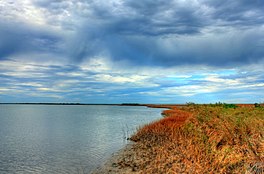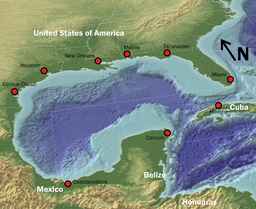| Gulf of Mexico | |
|---|---|
 Gulf of Mexico coastline near Galveston, Texas | |
 Bathymetry of the Gulf of Mexico | |
| Location | American Mediterranean Sea |
| Coordinates | 25°N 90°W / 25°N 90°W |
| River sources | Rio Grande, Mississippi River, Mobile River, Panuco River, Jamapa River, Pascagoula River, Tecolutla River, Usumacinta River, Apalachicola river |
| Ocean/sea sources | Atlantic Ocean, Caribbean Sea |
| Basin countries | |
| Max. width | 1,500 km (932.06 mi) |
| Surface area | 1,550,000 km2 (600,000 sq mi) |
| Average depth | 1,615 metres (5,299 ft)[1] |
| Max. depth | 3,750 to 4,384 metres (12,303 to 14,383 ft)[1] |
| Settlements | Veracruz, Houston, New Orleans, Corpus Christi, Tampa, Havana, Southwest Florida, Mobile, Gulfport, Tampico, Key West, Cancún, Ciudad del Carmen, Coatzacoalcos, Panama City |

The Gulf of Mexico (Spanish: Golfo de México) is an ocean basin and a marginal sea of the Atlantic Ocean,[2] mostly surrounded by the North American continent.[3] It is bounded on the northeast, north and northwest by the Gulf Coast of the United States; on the southwest and south by the Mexican states of Tamaulipas, Veracruz, Tabasco, Campeche, Yucatán, and Quintana Roo; and on the southeast by Cuba. The Southern U.S. states of Texas, Louisiana, Mississippi, Alabama, and Florida, which border the gulf on the north, are often referred to as the "Third Coast" of the United States (in addition to its Atlantic and Pacific coasts).
The Gulf of Mexico took shape approximately 300 million years ago as a result of plate tectonics.[4] The Gulf of Mexico basin is roughly oval in shape and is approximately 810 nautical miles (1,500 km; 930 mi) wide. Its floor consists of sedimentary rocks and recent sediments. It is connected to part of the Atlantic Ocean through the Straits of Florida between the U.S. and Cuba, and with the Caribbean Sea via the Yucatán Channel between Mexico and Cuba. Because of its narrow connection to the Atlantic Ocean, the gulf experiences very small tidal ranges. The size of the gulf basin is approximately 1.6 million km2 (620,000 sq mi). Almost half of the basin consists of shallow continental shelf waters. The volume of water in the basin is roughly 2.4×106 cubic kilometers (5.8×105 cubic miles).[5] The gulf is one of the most important offshore petroleum production regions in the world, making up one-sixth of the United States' total production.[6]
- ^ a b "General Facts about the Gulf of Mexico". GulfBase.org. Archived from the original on December 10, 2009. Retrieved November 27, 2009.
- ^ "Gulf of Mexico – a sea in Atlantic Ocean". www.deepseawaters.com. Archived from the original on October 31, 2020. Retrieved May 30, 2017.
- ^ "Gulf of Mexico". Geographic Names Information System. January 1, 2000. Archived from the original on December 31, 2020. Retrieved July 8, 2010.
- ^ Huerta, A.D., and D.L. Harry (2012) Wilson cycles, tectonic inheritance, and rifting of the North American Gulf of Mexico continental margin. Geosphere. 8(1):GES00725.1, first published on March 6, 2012, doi:10.1130/GES00725.1
- ^ "General Facts about the Gulf of Mexico". epa.gov. Archived from the original on October 3, 2006. Retrieved December 12, 2020.
- ^ "Gulf of Mexico Fact Sheet". U.S. Energy Information Administration. Archived from the original on December 18, 2020. Retrieved March 26, 2018.